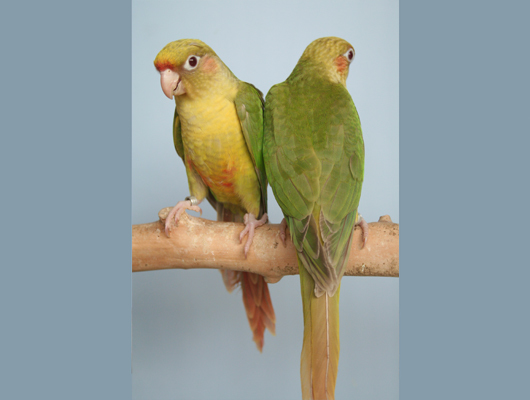The beautiful fallow mutant of the frontalis

Description of the mutation
This mainly pastel yellow bird has red eyes. Whereas the wild-coloured bird has a brown-red mark above his black bill, the fallow has a striking bright red mark above an ivory bill. The brown spots on the ears of the wild-colour have become light orange with the fallow and the legs are flesh-coloured with white nails whereas the wild-coloured brown-eared parakeet has black legs with black nails.
In short: a completely different mutation and a magnificent bird, highly appreciated by many parakeet-lovers!
Slowly and judiciously building up a breeding programme is vitally important for this mutation
First of all, this mutation has a recessive inheritance, which means that it is less fast than sex-linked inheritance. Moreover, red-eyed birds are usually a little weaker than black-eyed birds.
Two very good reasons to proceed slowly and well thought-out if we want to preserve this wonderful mutation! It is of vital importance that we avoid inbreeding with this mutation as much as possible.
Start by breeding non-consanguineous blood-ties with wild-coloured birds
In 2001, the Dutchman Cees Helmonds – as far as I know the first breeder of a brown-eared fallow – sold me a set of four female fallows from different couples. I paired these females with four completely non-consanguineous wild-coloured birds: one own breeding bird and three non-consanguineous wild-coloured males of three other bird-lovers.
Breeding with this mutation of the brown-ears did not run as smoothly as with the mutations of the green-cheeked parakeet (the pyrrhura molinae).
It took me two years to breed 10 to 15 strong split birds with these 4 pairs. The problem with the pyrrhura frontalis is that the couples do not always get along quite as good as with the pyrrhura molinae, especially if the birds have mated before with another bird (e.g. my own breeding male). By way of illustration: the combination fallow x wild-colour gives 100% split birds for the fallow!
The past 2 years I have on the one hand paired or tried to pair my ‘old’ female fallows with split birds from another couple: e.g. female fallow couple 1 x split bird young from couple 4… On the other hand I also paired 2 split birds from 2 of the 4 different breeding pairs.
Pairing the ‘old’ female fallows with the younger split birds was not as easy as I thought it would be. The combination split x split gave good breeding results though, but the chance that two split birds give fallow birds is obviously smaller (25%). This was already clear last year: considerable number of young, but hardly any fallows! But I have more luck this year: from a pair of split birds that only gave green young last year, I have now bred 5 young, of which no less than 4 fallows! A matter of luck! The only disadvantage of the green young from a pair of split birds is that they are all POSSIBLE splits for the fallow! They all have to be tested, preferably in combination with a fallow bird.
Keeping on avoiding inbreeding and weak birds
It is very important to keep on breeding non-consanguineous blood-ties. In this respect, I have bought the past two years a number of wild-coloured birds, split birds and fallows in order to strengthen and preserve the mutation.
I also definitely advise against pairing two fallow birds, because this weakens this mutation. My principle is: never pair two red-eyes!
Some advisable combinations:
fallow x fallow:
- 100% green/ fallow
green/ fallow x green/ fallow:
- 25% fallow
- 25% green/ fallow
- 50% green
green/ fallow x fallow:
- 50% fallow
- 50% green/ fallow
Attention:
For many years now, I have the ‘dark green’ and ‘olive’ brown-ears in my possession. After years of breeding experience, I am convinced that these are single and double factor misty birds, a mutation which already exists with other pyrrhura species.
